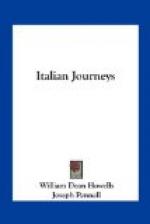As we passed, in his studio, from one room to another, the workman who showed the marbles surprised and delighted us by asking if we would like to see the sculptor, and took us up into the little room where Gibson worked. He was engaged upon a bass-relief,—a visit of Psyche to the Zephyrs, or something equally aerial and mythological,—and received us very simply and naturally, and at once began with some quaint talk about the subject in hand. When we mentioned our pleasure in his colored marbles we touched the right spring, and he went on to speak of his favorite theory with visible delight, making occasional pauses to bestow a touch on the bass-relief, and coming back to his theme with that self-corroborative “Yes!” of his, which Hawthorne has immortalized. He was dressed with extraordinary slovenliness and indifference to clothes, had no collar, I think, and evidently did not know what he had on. Every thing about him bespoke the utmost unconsciousness and democratic plainness of life, so that I could readily believe a story I heard of him. Having dined the greater part of his life in Roman restaurants where it is but wholesome to go over your plate, glass, spoon, and knife and fork with your napkin before using them, the great sculptor had acquired such habits of neatness that at table in the most aristocratic house in England he absent-mindedly went through all that ceremony of cleansing and wiping. It is a story they tell in Rome, where every body is anecdoted, and not always so good-naturedly.
IX.
One Sunday afternoon we went with some artistic friends to visit the studio of the great German painter, Overbeck; and since I first read Uhland I have known no pleasure so illogical as I felt in looking at this painter’s drawings. In the sensuous heart of objective Italy he treats the themes of mediaeval Catholicism with the most subjective feeling, and I thought I perceived in his work the enthusiasm which led many Protestant German painters and poets of the romantic school back into the twilight of the Romish faith, in the hope that they might thus realize to themselves something of the earnestness which animated the elder Christian artists. Overbeck’s work is beautiful, but it is unreal, and expresses the sentiment of no time; as the work of the romantic German poets seems without relation to any world men ever lived in.
Walking from the painter’s house, two of us parted with the rest on the steps of the Church of Santa Maria Maggiore, and pursued our stroll through the gate of San Lorenzo out upon the Campagna, which tempts and tempts the sojourner at Rome, until at last he must go and see—if it will give him the fever. And, alas! there I caught the Roman fever—the longing that burns one who has once been in Rome to go again—that will not be cured by all the cool contemptuous things he may think or say of the Eternal City; that fills him with fond memories of its fascination, and makes it forever desired.




